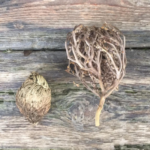The real Rose of Jericho
The Rose of Jericho ‘Resurrection Plant’
The Rose of Jericho, often referred to as the ‘Resurrection Plant,’ is a botanical wonder known for its unique ability to survive extreme dehydration and seemingly come back to life. Here’s an in-depth exploration of this fascinating plant:
Historical Significance and Literature
The Rose of Jericho has a rich history in literature, religion, and medicine. Both true and false varieties of the plant have been significant throughout the ages, with mentions in various cultural contexts. This historical significance adds to the mystique surrounding the Resurrection Plant .
Survival Mechanism: Master of Resurrection
The plant exhibits remarkable survival mechanisms. When faced with drought or extreme conditions, it undergoes a process of curling its branches and appearing lifeless. This state allows it to endure harsh conditions until it encounters water again. Upon rehydration, the Rose of Jericho miraculously unfurls its branches, symbolizing rebirth and resilience. This repetitive cycle of hibernation has earned it the title of the ‘resurrection plant’.
Symbolism: Transformation and Renewal
The Rose of Jericho holds symbolic significance, representing transformation and renewal. Its ability to undergo periods of dormancy and revival has led to its association with themes of regeneration and the cyclical nature of life. This symbolism has captured the imagination of many, making it a popular choice for those seeking a plant with deeper meaning in various cultural and spiritual practices .
Distinct Characteristics: True vs. False Rose of Jericho
The term ‘Rose of Jericho’ may refer to two unrelated plants, each possessing resurrection properties. The true Rose of Jericho or the Real Rose of Jericho , scientifically known as Anastatica hierochuntica, is distinct from the false Rose of Jericho variety, often referred to as Selaginella lepidophylla or ‘resurrection moss.’ Both share the ability to revive after desiccation, but they belong to different botanical families.

Cultural Uses and Practices
Beyond its botanical marvel, the Rose of Jericho has found a place in various cultural practices. It is often utilized in rituals, ceremonies, and spiritual activities where its symbolic significance aligns with themes of rebirth, purification, and positive energy. The plant’s presence is believed to bring about transformative energies, making it a cherished element in certain traditions.
Care and Cultivation
Cultivating the Rose of Jericho requires an understanding of its unique characteristics. While it can endure periods of drought, providing occasional hydration is essential for its continued well-being. This care involves submerging the dried plant in water, allowing it to absorb moisture and initiate the unfolding process. Proper care ensures the plant’s vitality and the opportunity to witness its mesmerizing resurrection cycles .
Caution: Misidentification and Sourcing
One must exercise caution when purchasing the Rose of Jericho, as misidentifications between the true and false varieties can occur. Additionally, ensuring the plant is sourced from reputable suppliers is crucial to guarantee its authenticity and quality. This is especially important for those seeking the plant for its symbolic and spiritual uses.
In conclusion, the Rose of Jericho, known as the ‘Resurrection Plant,’ captivates with its ability to endure and revive, symbolizing themes of transformation and renewal. Its historical significance, cultural uses, and unique characteristics contribute to its allure, making it not just a botanical marvel but a plant deeply embedded in the tapestry of human culture and spirituality.





